Content [show]
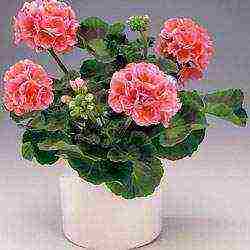 For almost a century, breeders all over the world have been breeding new and new varieties of pelargonium. Thanks to their labors, an incredibly large number of different varieties and varieties of this ornamental plant were obtained. The culture is not overly demanding on growing conditions and, with proper care, will surely answer you with lush, luxurious flowering. For your attention detailed information about zonal pelargonium, as well as its best varieties (photos with names and descriptions are attached).
For almost a century, breeders all over the world have been breeding new and new varieties of pelargonium. Thanks to their labors, an incredibly large number of different varieties and varieties of this ornamental plant were obtained. The culture is not overly demanding on growing conditions and, with proper care, will surely answer you with lush, luxurious flowering. For your attention detailed information about zonal pelargonium, as well as its best varieties (photos with names and descriptions are attached).
About zonal pelargonium
This is one of the most common plant groups, represented by a large number of species and varieties. Zonal varieties belonging to the group of the same name are considered for the reason that they have a certain zone on the leaves, painted in a different color (most often in the form of a small ring-shaped or rounded spot). Pelargonium zonal is perfect for growing not only indoors, but also in open areas.
The variety is represented by an erect, fairly branched and powerful bush, densely covered with foliage. The bush is covered with small lush umbrella flowers. The leaves are heavily pubescent, have a specific smell. Zonal pelargoniums are also divided into several varieties, depending on the number of petals on the flowers. So, they are 5-8-petal (sometimes more).
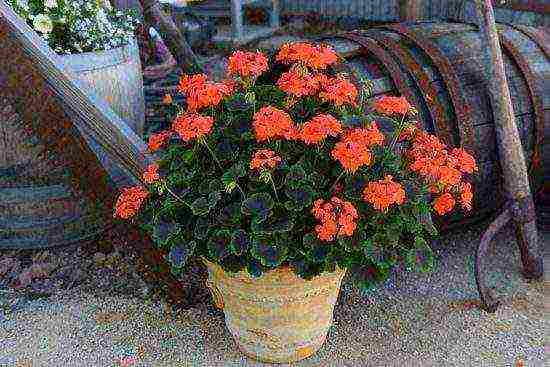
Pelargonium is an unpretentious plant
Zonal pelargonium is a plant that is rather unpretentious to growing conditions, but quite demanding to care for. It is necessary to provide it with the right amount of solar heat and light, nutritious and regular feeding, saturate it with moisture, etc.
Advice. During the winter, it is necessary to provide the plant with sufficient access to cool air. If this is not possible, remove as many bare shoots from the plant as possible in the spring.
Basic classification of zonal pelargonium
Zonal pelargonium, in turn, can be conditionally divided into several more subgroups:
- Rosaceae. All varieties presented in this category have luxurious double flowers, outwardly very reminiscent of classic roses.

Rosaceous pelargonium
- Tulip-shaped. Flowers of varieties from this group are small flowers collected in inflorescences. Outwardly, they resemble small unopened tulip-shaped buds. The petals of tulip-shaped pelargoniums are distinguished by a rather unusual appearance: they are slightly inclined inward and lowered, as if they have already begun to wither. This in no way suggests that the plants are really withering. In fact, the sluggish appearance of the petals is a specific feature of the variety.
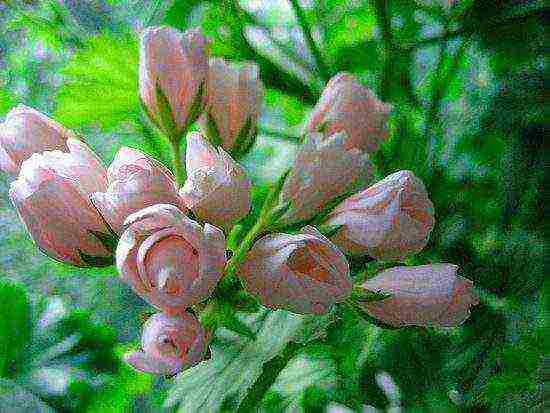
Tulip pelargonium
- Star-shaped. Star-shaped pelargoniums are completely different from their "fellow tribesmen": the flowers of these dwarf plants have an unusual shape of a pointed star. Moreover, quite often the two largest petals have an elongated shape with a sharp end, which makes them different from the rest.
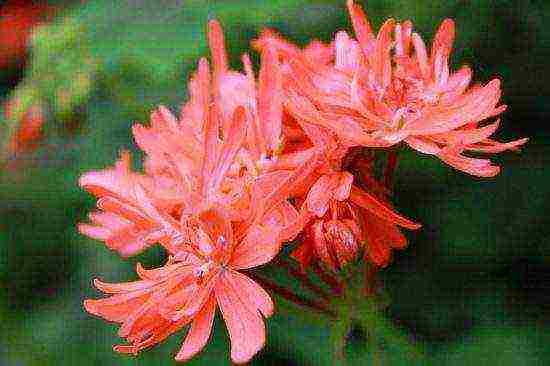
Star pelargonium
- Cloves. The varieties presented in this category are outwardly very similar to garden carnations: they are just as large, with carved petals of a fairly bright shade.

Clove pelargonium
- Cactus. A fairly rare variety of zonal pelargonium, which is represented by a fairly large, strongly leafy bush. The leaves are wide, bright green. The flowers of cactus varieties look quite unusual: their petals seem to be rolled into narrow tubes.Quite often they have a slightly "disheveled" appearance.
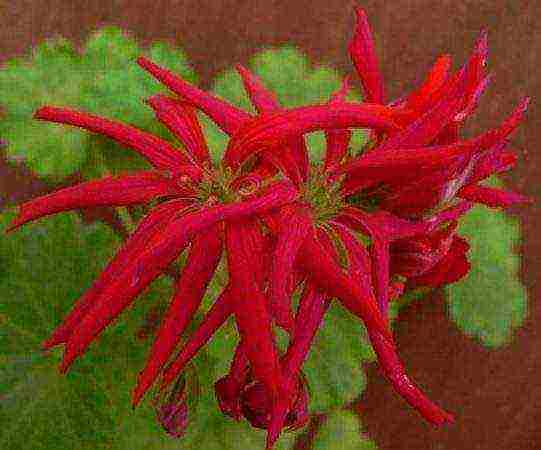
Cactus pelargonium
- Deacons. Quite young hybrids that appeared on the world flower market less than 50 years ago. They are represented by a very compact, profusely flowering bush with a small rosette of delicate peach, pink or red shades.
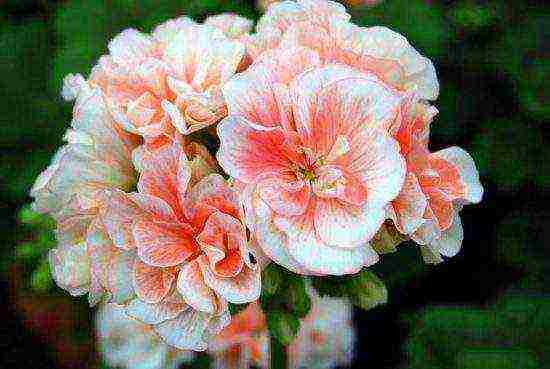
Pelargonium deacon
Let's take a closer look at several of the best representatives in each category of the zonal variety of pelargonium. Among the most popular pink varieties there are several:
- April Snow is a neat dwarf plant with small double pink flowers in the form of roses.
- Denise is a vigorous plant that every year is covered with a large double head of pink or peach color.
- Monseruds Rosen is not easy to grow - it is quite difficult to form the necessary shape, it is distinguished by a luxurious burgundy flowering.
Among the most popular star varieties pelargonium can be distinguished as follows:
- Aunty Pam - Stellаr. The variety is represented by a fairly compact well-branched bush, densely covered with luxurious bright pink flower rosettes. Externally, the flower petals resemble a small double carnation.
- Borthwood - Stellаr. Another excellent star variety, represented by a highly flowering dwarf bush, the leaves of which are slightly reminiscent of frog legs in shape.
- Fandango. Quite an unusual variety, the flowers of which look slightly "shabby": the shape of the petals is a little torn, with indistinct edges. The flowering of plants is abundant, lush, the flowers are distinguished by a pleasant soft coral shade.
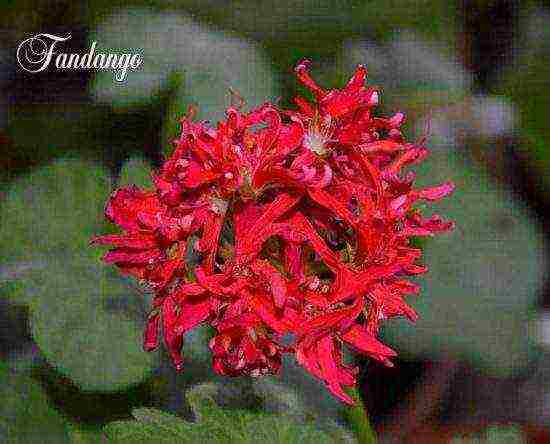
Pelargonium Fandango
Among cactus varieties pelargoniums include the following:
- Fascination (the petals of the plant are quite long, with the edges bent downward, which makes their appearance very extravagant, resembling a little human nails);
- Noel (the petals of the flowers of the plant have a delicate white color and a twisted shape, a pinkish anther rises in the center).
Advice. In order to grow luxurious, lushly blooming pelargonium in your home, it is necessary to periodically prune its branches (it is advisable to carry out this procedure in the autumn period). This will speed up the growth of the plant and improve its appearance.
This concludes our acquaintance with one of the varieties of such an unusual and pleasant plant to grow as zonal pelargonium. Good luck!
Pelargonium varieties: video
Among the most attractive garden and indoor plants, zonal pelargonium occupies a separate place. This flower is a frequent visitor to government agencies and parks. However, there are so many varieties of zonal pelargonium that you can always pick up a flower for your apartment.
Zone View History
Geranium of the genus Pelargonium zonal was first discovered in the middle of the last millennium on the African continent. The plant attracted the discoverers with its bright flowers and unusual shape of the capsule. This shape resembled the beak of a stork, which is why the new species was given the name Pelargoniums - derived from the Greek "πελαργός", which means "stork". And the word "zonal" appeared in the name due to the special color of the leaf plate - in spring and summer, a small zone appears on it, painted in a different color. Thus, the Latin name for the zonal geranium was formed - Zonal pelargoniums.

For the first time, zonal pelargonium came to the territory of Europe from Africa in the 18th century - it was brought by British sailors to their homeland. There the flower gained wide popularity and until the beginning of the twentieth century remained a symbol not only of the Victorian era, but also of the English bourgeois life in principle. At the time when the popularity of the plant in the British Isles began to fall, zonal geranium was already known throughout Eurasia, thanks to which its old varieties were actively bred and new ones were bred.
To date, more than 350 varieties of Zonal pelargoniums are known. The flower is grown both indoors and outdoors, and the variety of colors allows you to choose a crop option for every taste.
The best varieties
As already mentioned, zonal pelargonium has more than three hundred species. The most common are:
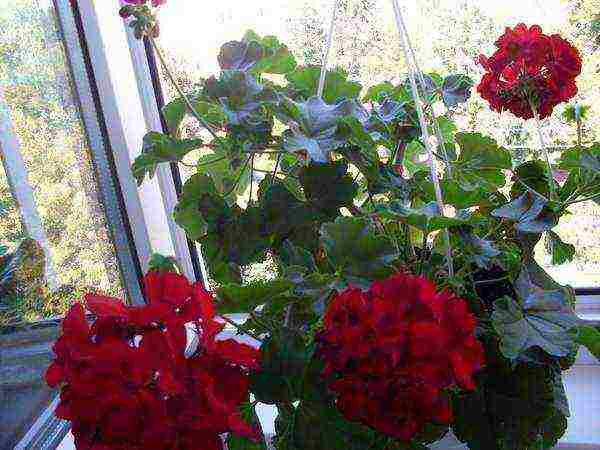
- Calliope Dark Red is a newly bred hybrid. The authors of this variety in the description must indicate the magnificent view of Calliope Dark Red - rich red double buds are located on a medium-sized shrub;
- another medium-sized variety Rafaella differs from Calliope Dark Red in larger inflorescences and a variety of shades - from pale pink to lilac;
- The Violet chandelier blooms with purple buds from May to October. This variety is suitable for both the street and the home, and with proper care, it will delight you with large inflorescences sitting on bright green stems;
- Pelargoniums of the PAC group (here we know as PAK) are more expensive hybrids. Most of them were bred in the last two decades. Varieties of PAK are distinguished by a wide variety of colors and shapes - flowers similar to roses and classic geraniums, white, blue and all shades of red. In our country, the most famous geranium hybrids under the following names are PAC Fireworks Red, PAC Fireworks Red-White, PAC Salmon Princess, PAC Viktor Improved , PAC Viva Carolina;
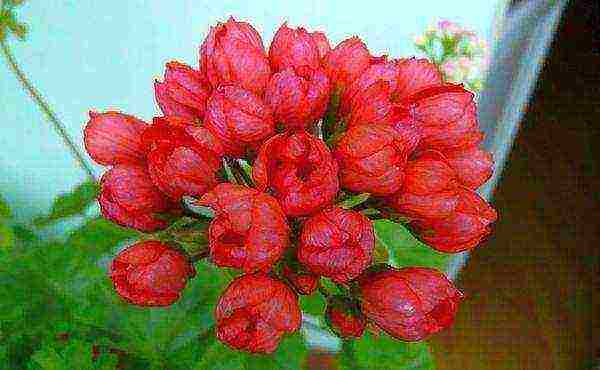
- incredibly beautiful hybrid Red Pandora belongs to tulip varieties. Inflorescences of Red Pandora resemble a set of small tulips of a delicate scarlet color. The variety blooms for a long time and does not require serious care;
- Pelargonium Montevideo grows into huge peony buds of a pale salmon color. The plant is medium-sized and suitable for growing in an apartment;
- Unicorn Zonartic Rose is a vigorous cross between the golden Lara Zonartic and the purple Lara Suzanne. The result is a plant with pale purple petals and large double leaves;
- another group of pelargoniums - Deacons. In this group, there are plants of various shades - platinum, orange, white, burgundy and others. The flowers are low, with sparse foliage. A number of varieties are bred in Italian Tuscany (Cato, Claudio, Eric, Bernd), other European countries are the homeland of others (Cupid, Emma Hawsley).
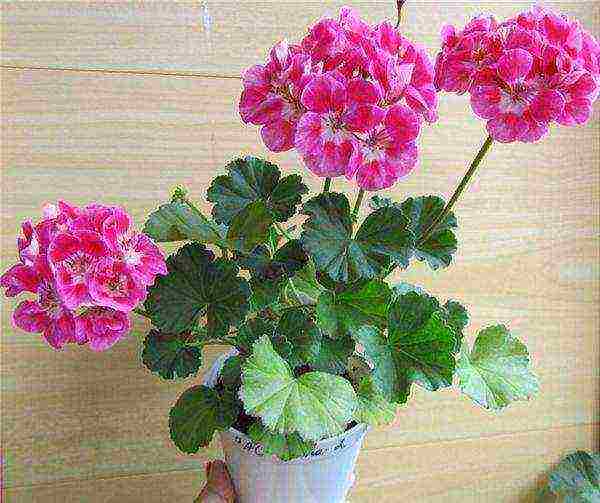
Features of growing and care
It is very easy to care for zonal pelargonium. All you need to do is choose the right planting spot and determine the correct watering schedule.
Home care is the most comfortable, since it does not require sheltering the plant for the winter and fighting rodents. However, there are also some nuances here. For example, if placing pelargonium on the street in spring and early summer is almost guaranteed to provide the plant with the required amount of light, then in the room you will have to find the brightest and most calm corner of the house - preferably a southeast window. If there is no such place, in winter the flower will have to be illuminated artificially - with the help of lamps.
Also, do not forget that sunburn has a detrimental effect on the condition of the foliage - protect your plants from direct sunlight and shade flowers in time.
The home conditions of our regions are ideal for growing zonal pelargonium - comfortable temperatures for a plant are considered to be from 12 to 24 ° C, which allows the flower not to fade even in winter. The same applies to humidity: low humidity during the heating season is not a cause for concern, because pelargonium does not need to be sprayed. All they need is regular watering after the soil dries out. In winter, the frequency of soil moistening can be reduced to 1 time in 10 days.

Zonal pelargoniums prefers loose soils. Special primers for this type of plants can be purchased at a flower shop or mixed by yourself. To do this, you need sheet soil, peat, charcoal and sand. All ingredients must be mixed in a 3: 1: 1: 1 ratio.
A change of soil is required for a flower once a year. When transplanting from pot to pot, the volume of the new vessel should not exceed the previous one by more than 15%.The plant is planted in the ground in the middle of spring and removed from there in the fall.
Zonal geranium does not need frequent feeding - it is enough to feed the plant with potassium-phosphate fertilizers before flowering, as well as mineral mixtures during the dormant period. In winter, limit feeding once every six weeks.
Pelargoniums are characterized by a high growth rate, which is why the timely formation of the bush becomes an important point. In the absence of pruning and removal of old shoots, the plant will stop blooming. Therefore, regularly remove old shoots, and also pinch the flower at points of growth no higher than above the sixth leaf.
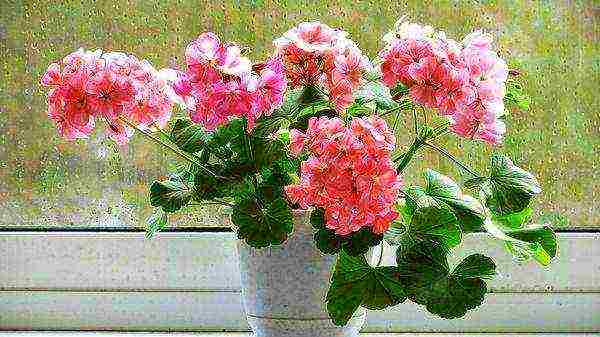
Zonal pelargonium, like other house plants, is often affected by pests and fungal diseases. In addition, improper care of the flower or its complete absence can become the cause of disease. To avoid problems, do not break the watering, transplanting and feeding regime, and also regularly check the plant for the presence of parasites (aphids, whiteflies, spider mites).
Breeding rules
Zonal geraniums are propagated mainly in two ways - by seeds and cuttings. The first method is suitable for those who want to grow a flower from scratch. On the package with seeds it should be written at what time it is recommended to grow seedlings - most often this is done at the end of winter.
Previously, the seeds are soaked in warm water, and then the substrate is transplanted and kept in a warm, well-lit place, regularly moistening and fertilizing. By spring, the sprouts grow so much that they can be transplanted into a pot, and in the summer such plants are able to give the first buds.
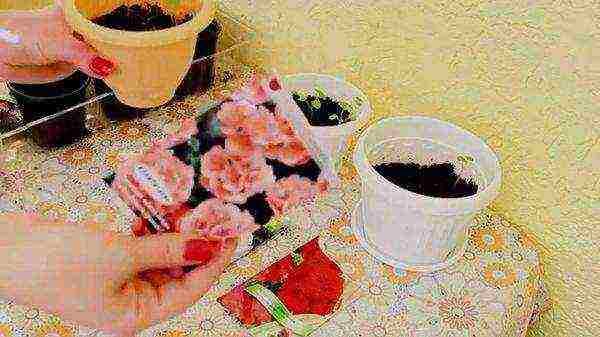
Propagation by cuttings helps to obtain the desired plant, which will be a complete copy of the mother flower. To do this, cut off the shoot from the mother plant, keep it in dry, humid conditions for a couple of days, and then, like an ordinary plant, transplant it into a pot with soil suitable for pelargonium. Previously, you can put the shoot in a glass of water and keep it there until the roots form, but the quality of growth will not change from this. It is recommended to water the young shoot regularly and keep it on a well-lit windowsill.
We wish you success in growing zonal pelargonium!
Video "Variety selection and reproduction of pelargonium"
In this video, you will learn how to choose the right pelargonium variety and propagate the plant.
 Geranium on the windowsill is a classic of the genre in home crop production. And if you think that this flower is too boring and suitable only for grandmother's chest of drawers, then you are deeply mistaken. Modern varieties of pelargonium may be completely different from the bored meter "kalachiki". And the flowers, and the shape of the leaves, and even their smell can be completely different. Interesting? Then let's try to figure out what an ordinary geranium can be.
Geranium on the windowsill is a classic of the genre in home crop production. And if you think that this flower is too boring and suitable only for grandmother's chest of drawers, then you are deeply mistaken. Modern varieties of pelargonium may be completely different from the bored meter "kalachiki". And the flowers, and the shape of the leaves, and even their smell can be completely different. Interesting? Then let's try to figure out what an ordinary geranium can be.
Variety of pelargonium species
The species and varietal diversity of pelargonium does not allow the adoption of a single classification of this plant. But the most common division into 6 types:
- pelargonium is zonal;
- ivy pelargoniums (ampelous);
- royal pelargoniums;
- pelargonium angels;
- unique;
- fragrant pelargoniums.
Zonal pelargoniums - Zonal pelargoniums
The most widespread species, represented by the largest number of varieties (over 75 thousand). This pelargonium received the designation “zonal” because on its leaf plates there is a “zone” painted in a different color - usually in the form of a ring or a color spot in the center. With a lack of lighting, for example, in winter, the "zone" disappears, and reappears in the spring.
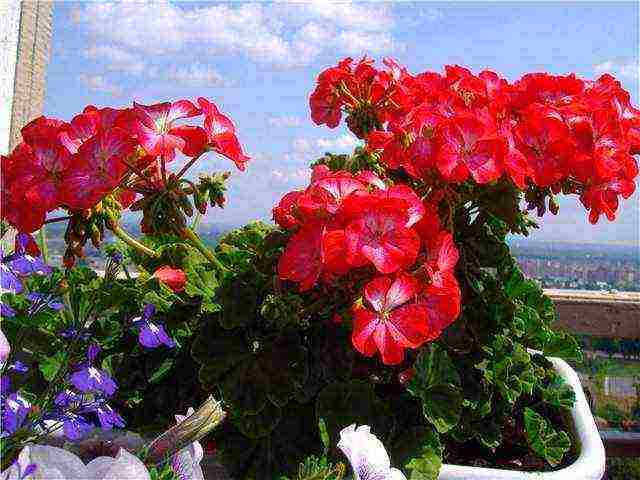 Zonal Pelargonium Orbit Scarlet Eye in balcony boxes
Zonal Pelargonium Orbit Scarlet Eye in balcony boxes
Pelargonium zonal is a densely leafy, erect bush with flowers collected in umbrella brushes. Her leaves are pubescent, have a specific smell.
They began to cultivate zonal pelargonium in culture in 1710. These inhabitants of the windowsills were tall and represented a long watchtower with small inflorescences. Later, breeders took up the development of shorter varieties that could be formed by pinching. The first such varieties appeared in 1844.
By the number of flower petals, zonal pelargoniums are divided into:
- non-double (Single Zonal pelargoniums) - the flower consists of 5 petals;
- semi-double (Semi-Double Pelargoium Zonale) - from 6-8 petals;
- terry (Double Zonal pelargoniums) - more than 8 petals.
Among the mass of varieties of zonal pelargoniums, separate subgroups are distinguished:
1. Rosaceae (Rose-bud Zonal pelargoniums)
Zonal pelargonium with flowers very similar to roses. The first mention of the subgroup appeared in 1876, in an article in the Journal of the Royal Horticultural Society. The most famous variety is Appleblossum Rosebud.
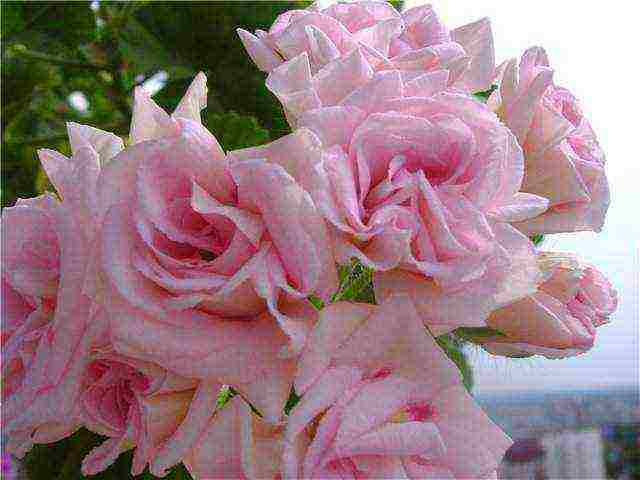 Zonal Pelargonium from the group of rosebud varieties - Millfield Rose
Zonal Pelargonium from the group of rosebud varieties - Millfield Rose
2. Tulip (Tulipe-bud pelargonium)
Pelargonium flowers resemble unopened tulip buds with 6-9 petals. The subgroup is characterized by dense flowering in the form of a bunch. Tulip pelargoniums were obtained in 1966 by the American Andrea family of breeders in Boston. It is believed that the ancestor of the subgroup was the sport (mutation) of Pelargonium Fiat, to the appearance of which varietal "tulips" sometimes return.
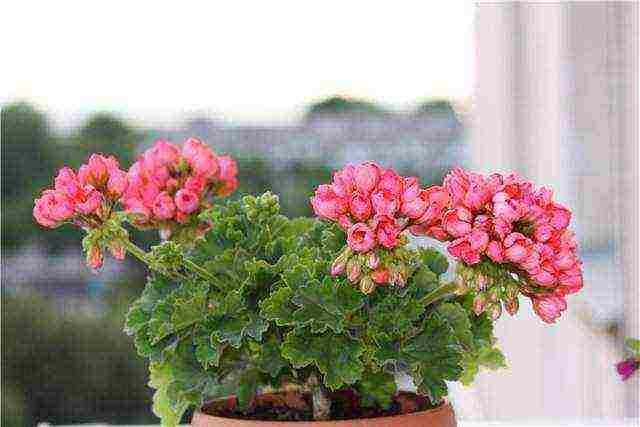 Tulip Pelargonium Patricia Andrea
Tulip Pelargonium Patricia Andrea
3. Carnation (Carnation Pelargonium)
Flowers of this subgroup resemble garden carnation flowers. They are large enough with carved petals.
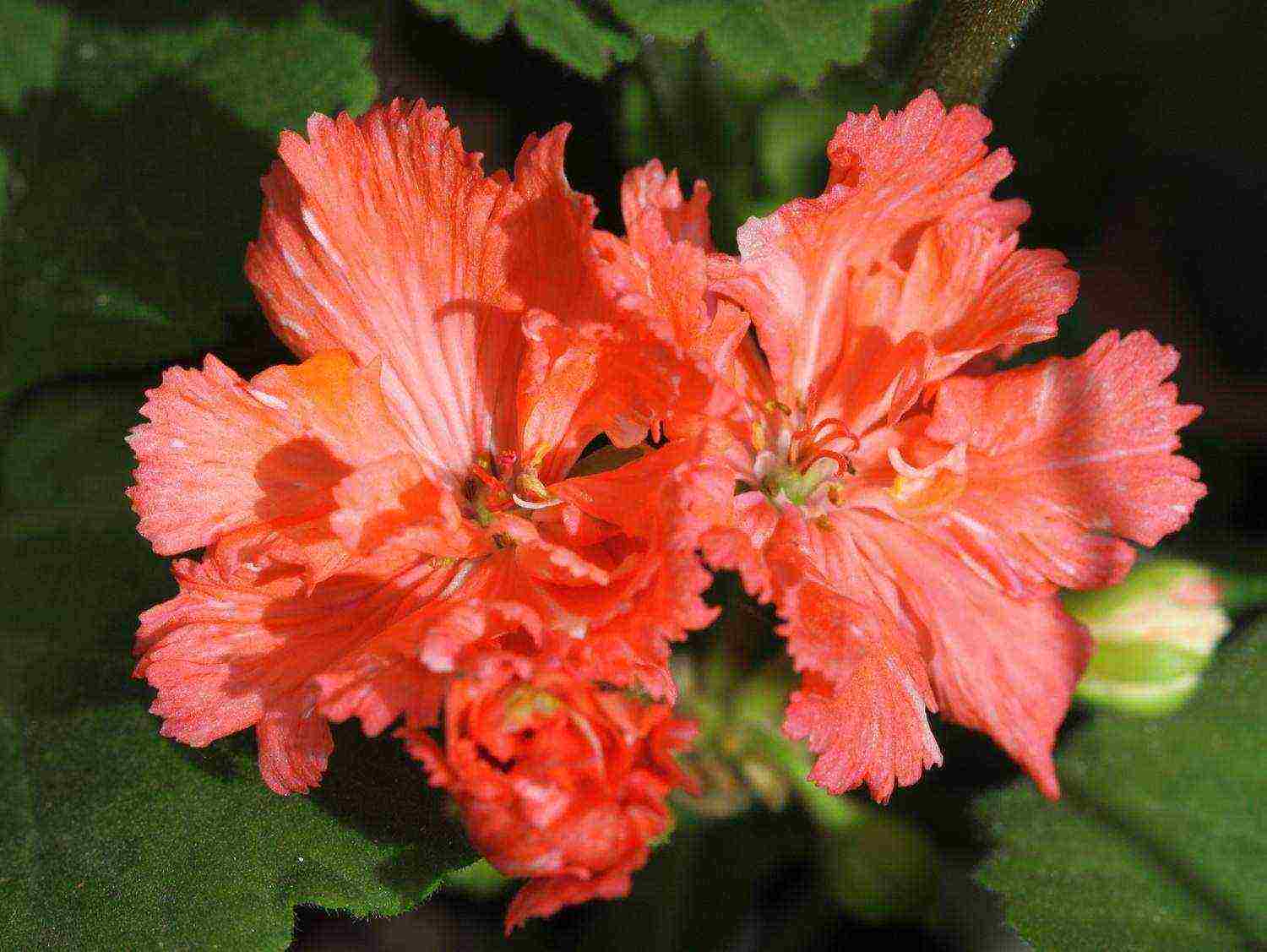 Clove Pelargonium - Diana Palmer cultivar
Clove Pelargonium - Diana Palmer cultivar
4. Stellar (Stellar Zonal Pelargonium)
In these zonal pelargoniums, both leaves and flowers have a sharp, angular, so-called "star" shape. Usually, the flower has two upper petals that are more elongated and narrower than the rest. For the first time, star-shaped pelargoniums appeared on the windowsills of amateur flower growers in the early 1950s. in Australia.
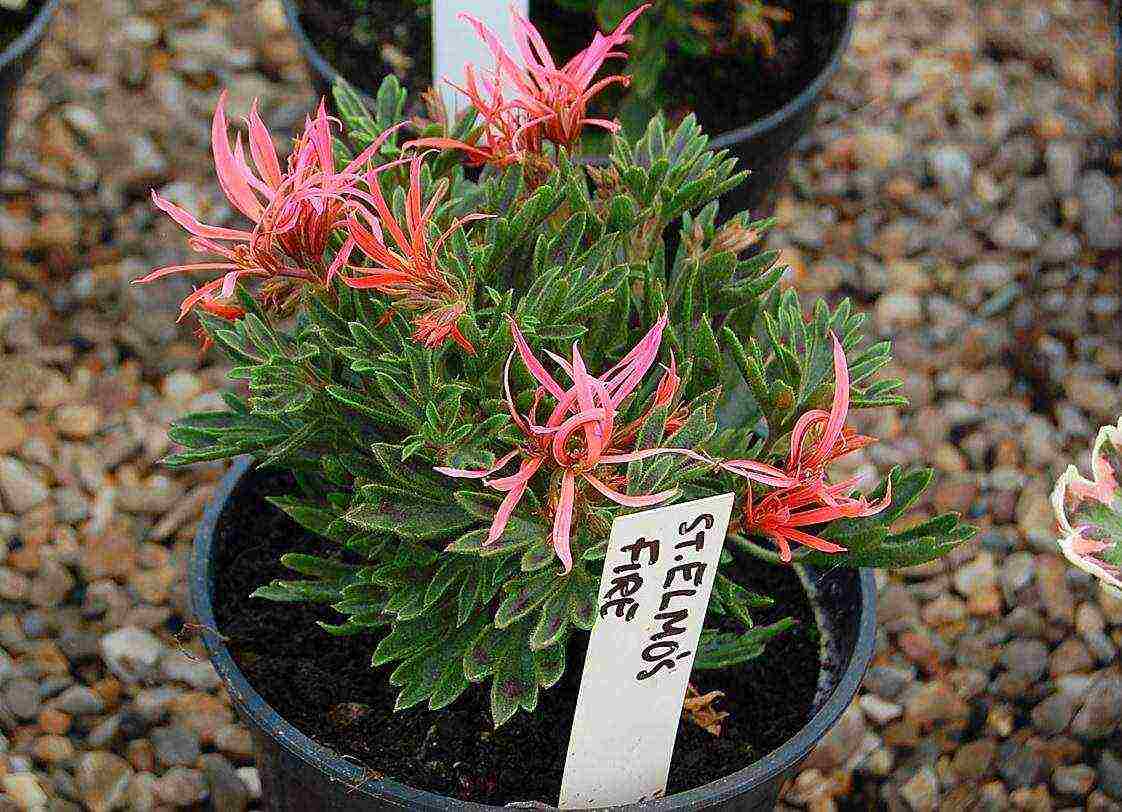 Star Pelargonium St. Elmos fire
Star Pelargonium St. Elmos fire
5. Cactus (Cactus-flowered Zonal pelargoniums)
A very rare subgroup of pelargonium, characterized by long, curled or curled flower petals. They often look "disheveled" or like cactus dahlia flowers. The cactus group has been known since the end of the 19th century, now most of the varietal assortment has been lost.
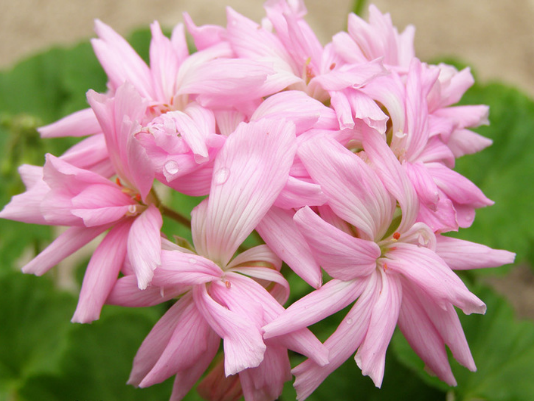 Pelargonium cactus Mrs. Salter bevis
Pelargonium cactus Mrs. Salter bevis
6. "Deacons"
The first "Deacons" arose from the crossing of the Orion zonal miniature and the Blue Peter ivy-leaved pelargonium. Breeder - Stanley Stringer. New varieties of geraniums were presented by him at the "Flower Show" in Chelsea in 1970. Features of this subgroup - compact, miniature bush, abundant flowering. The flowers are red, orange or pink in different shades.
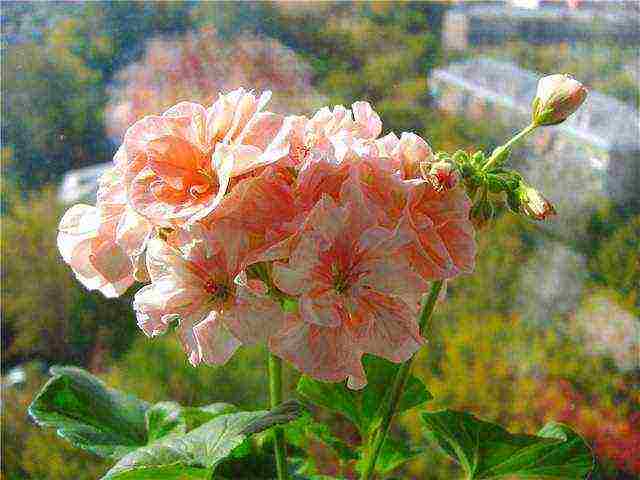 Zonal pelargonium of the "Deacons" group, variety Deacon Birthday
Zonal pelargonium of the "Deacons" group, variety Deacon Birthday
Pelargonium ivy - ampelous plants with hanging or creeping shoots 25-100 cm long. They are very popular when decorating balconies and loggias, although they can also be used outdoors as ground covers.
Flowers of ampelous pelargonium can be of any shape: non-double, double, rosebud. Their colors are quite extensive: from snow-white to wine-burgundy, almost black.
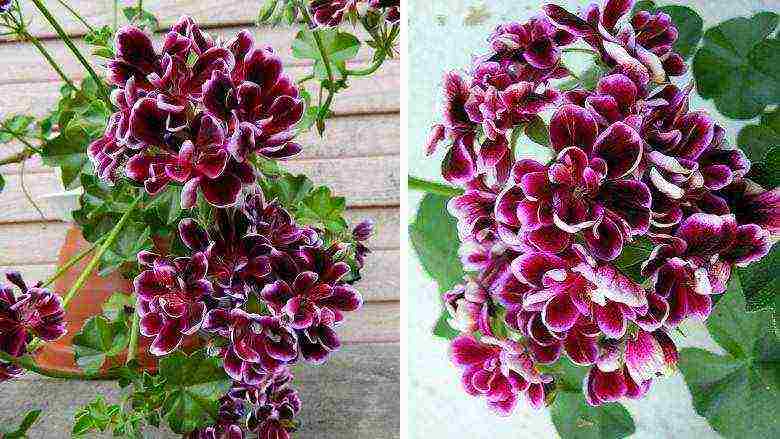 Pelargonium ivy Bonito
Pelargonium ivy Bonito
The leaves of the ampelous geranium are smooth, similar to ivy leaves (hence the name of the group). In most varieties, the leaves are quite tough and dense.
Geranium ampelous in culture has been cultivated since the beginning of the 18th century, but it received wide recognition only in the middle of the 19th century. From that moment, breeders began to take an active interest in this plant, and in 1877 they released the first terry ampelous pelargonium of the Konig Albert variety.
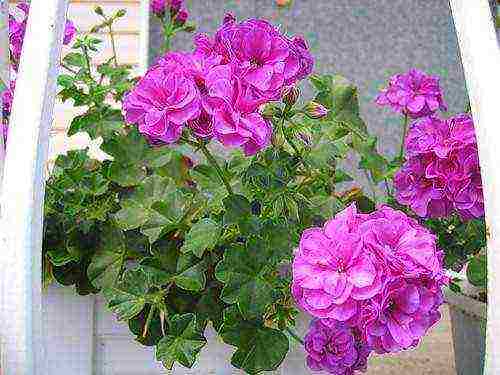 Geranium ampelous Pac Blue Sybil Royal Pelargoniums - Regal pelargoniums
Geranium ampelous Pac Blue Sybil Royal Pelargoniums - Regal pelargoniums
Royal pelargoniums are powerful bushy plants, reaching a height of 50 cm. The flowers are large, up to 4-7 cm in diameter. The edges of the petals are often corrugated and fringed. Their color is never uniform due to the obligatory presence of dark spots or stripes along the veins. Many varieties of royal geraniums have darker upper petals than lower ones. The predominant colors are white, burgundy, dark pink, purple.
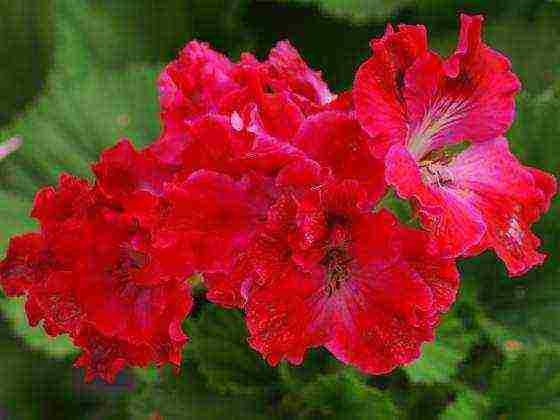 Royal Pelargonium Tunia's Perfecta
Royal Pelargonium Tunia's Perfecta
The royal geranium has broad, serrated leaves. They resemble maple leaves in shape, but with smaller and more frequent "teeth".
By their nature, royal geraniums are more capricious than other groups. The period of its flowering is no more than 3-4 months (for comparison: zonal pelargonium with good illumination can bloom all year round, without stopping) and then only with a properly arranged period of winter dormancy. In order for the budding to occur, royal geraniums should be kept at a temperature of 10-12 ° C in winter.
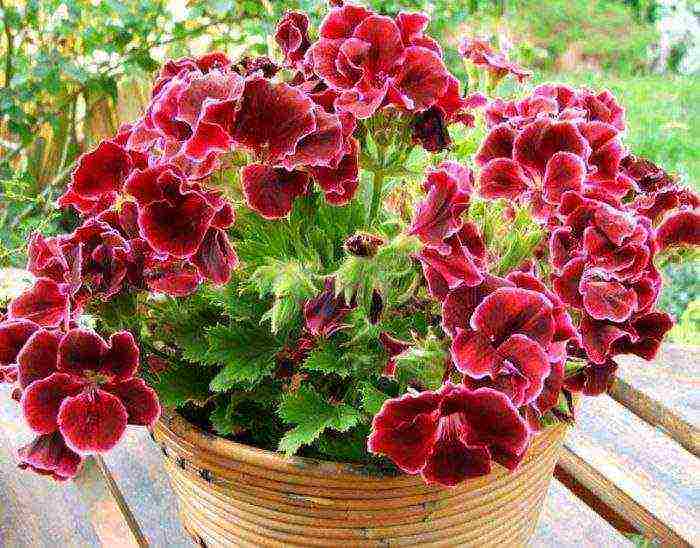 In order for the royal pelargonium to bloom, it needs 2-3 months of cool wintering
In order for the royal pelargonium to bloom, it needs 2-3 months of cool wintering
Many growers believe that "Angels" belong to the variety series of royal pelargoniums. But this is not the case. The first true "Angels" were obtained by the English florist Langley Smith by crossing the royal and curly pelargonium. It happened in the 1930s. Later, new varieties of Pelargonium "Angels" were bred in the process of hybridization within the group itself.
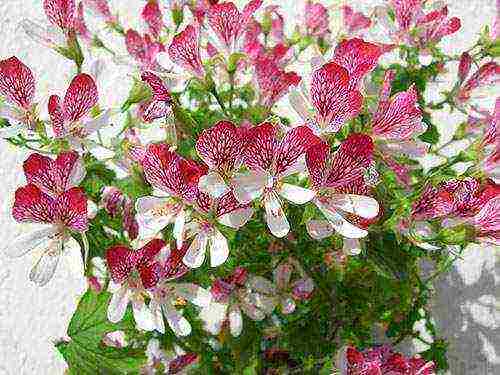 Pelargonium "Angel" - grade Eskay Saar
Pelargonium "Angel" - grade Eskay Saar
The "Angels" differ from the royal pelargoniums by the smaller size of leaves and flowers (diameter 1-2 cm). The type of growth of the "queens" is vertical, while the "angels" form ampelous bushes.
"Angels" are more persistent and unpretentious than varieties of royal geraniums. They grow fast, need a lot of light and tolerate dry conditions well.
Pelargoniums "Unique" - Unique pelargoniums
"Unicums" - an old group of pelargoniums, cultivated since the 60s of the 18th century. It was obtained by crossing the royal and brilliant (P. fulgidum) pelargonium. The first variety was named Old Unique. Subsequently, all representatives of the group were united under the common name Unique pelargoniums.
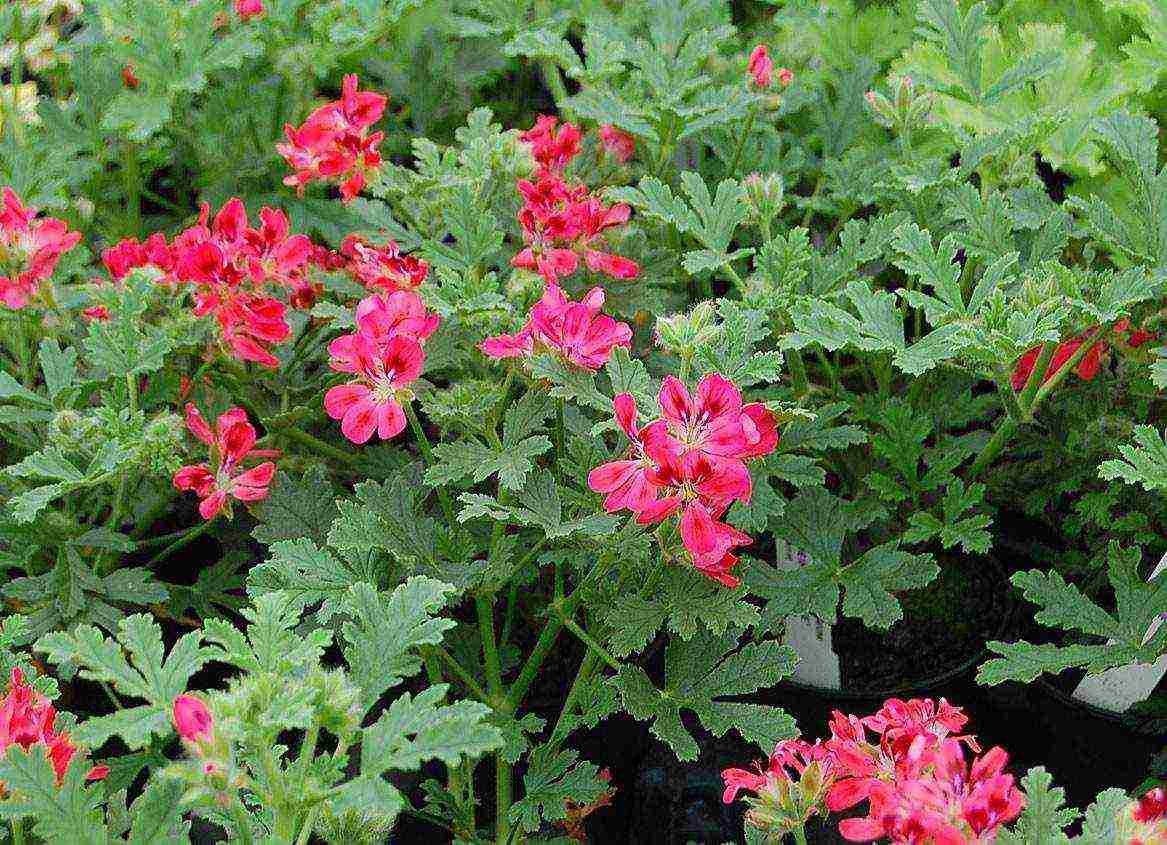 Pelargonium "Unique" - Robin's Unique
Pelargonium "Unique" - Robin's Unique
Flowers "Unicums" are similar to the flowers of royal pelargonium, but smaller in size. Leaves are dissected, sometimes with a fragrant smell. For example, the leaves of Paton's Unique have a sweet, peachy aroma.
During the Victorian era, Unicums were very popular as garden plants. Plants are rather large and tall. To bloom, their growth should be 40-50 cm. They bush poorly on their own, pinching or pruning is required.
Scented-leaved pelargoniums
Fragrant geraniums form a group of varieties, the leaves of which exude aromas of different shades.
Most of the "fragrant" outwardly unsightly, their flowers are small, simple, most often pink or white. Leaves are palmate-lobed, with uneven angular or wavy edges. The plant forms a branched, loose bush that grows up to 1 m in height.
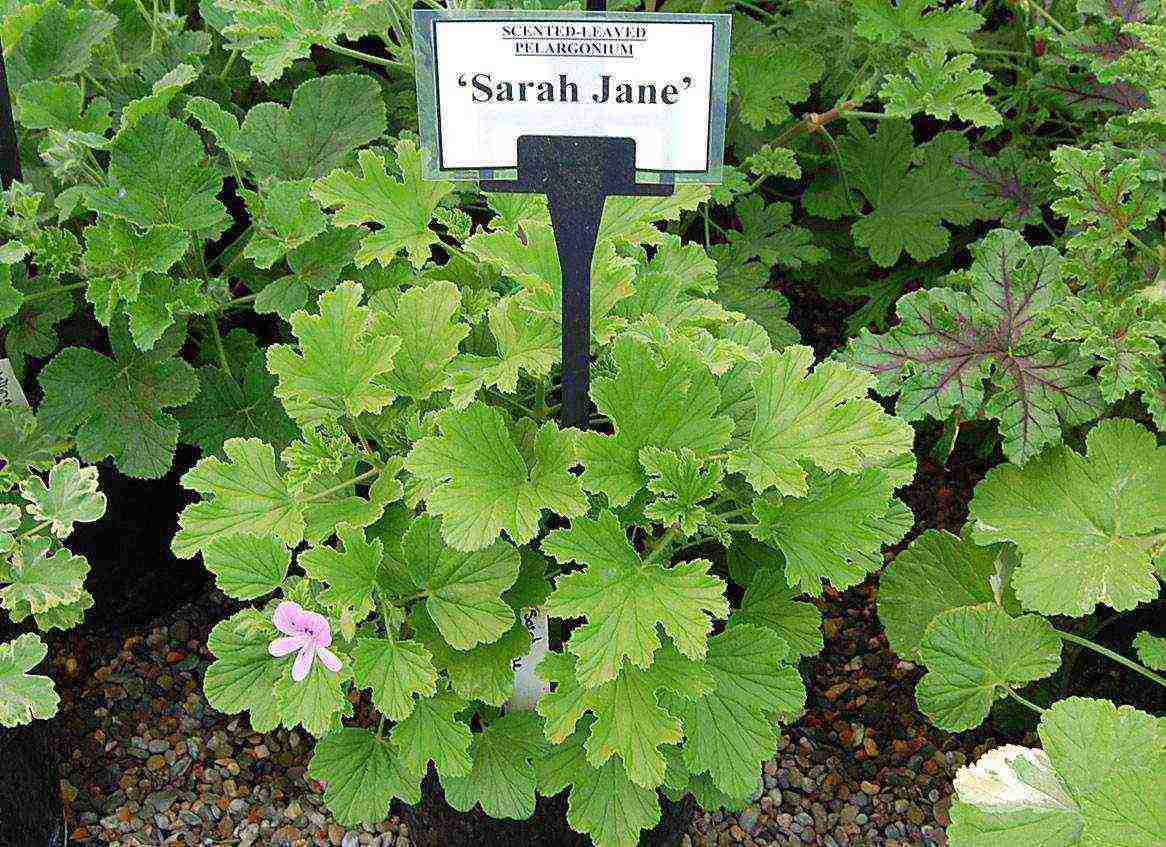 Sarah Jane fragrant geranium has a light citrus aroma
Sarah Jane fragrant geranium has a light citrus aroma
Scented geraniums are grown for their scent. Their leaves can smell like pineapple, peach, apple, verbena, grapefruit, nutmeg, oriental spices, roses, pine needles, wormwood, mint, etc.
Choose varieties and flavors:
- Islington Peppermint - pure mint flavor, no impurities
- Mabel Gray - strong and distinct lemon scent
- Brilliantine - a perfumery scent similar to cologne
- Fruity - sweet fruity scent
- Orange Fizz - Strongest Lemon Peel Flavor
- Candy Dancer - rose scent
- P.grossularioides - sweet, confectionery smell with hints of coconut
- p. odoratissimum - apple flavor
- Lady Plymouth - smells like menthol
- Gemstone - delicate lemon balm scent
- Orsett - pine scent (juniper, cypress)
- Clorinda - bright scent of spruce needles
- Fragran - clear scent of wormwood
- Staghorn Oak - strong forest scent
- Godfrey's Pride - "perfume" with notes of pine, spices and mint
- Fair Ellen - "forest", woody scent
- Fernleaf - pine needles scent
- p. Moliconum - Smells like pineapple
Most of the fragrant geraniums appeared in the process of crossing the species pelargonium. Although, some of them themselves are specific (for example, p. Odoratissimum - the most fragrant pelargonium).
In the 18th century, fragrant geranium was used in wealthy homes as a natural air freshener, "perfume" on the windowsill. Until now, this plant is very popular among amateur flower growers, private collectors.
Let's resume such a competition.
Competition "The most abundant flowering pelargonium" Contestants must show a full-length photo of blooming pelargonium so that you can see the size of the plant and the number of flowers on it. So, take pictures of your favorites in spring and summer!
The plant can be indoor, balcony, garden, most importantly, filmed in a tidy condition and there should be no disorder in the background.
The photo and the plant must be yours.
If you know the name of the variety, then sign up for a better search in the network of our competition.
The competition will last from March 28 to September 15, 2016.
All participants in the competition will receive a prize - a virtual medal for participating in the competition.


